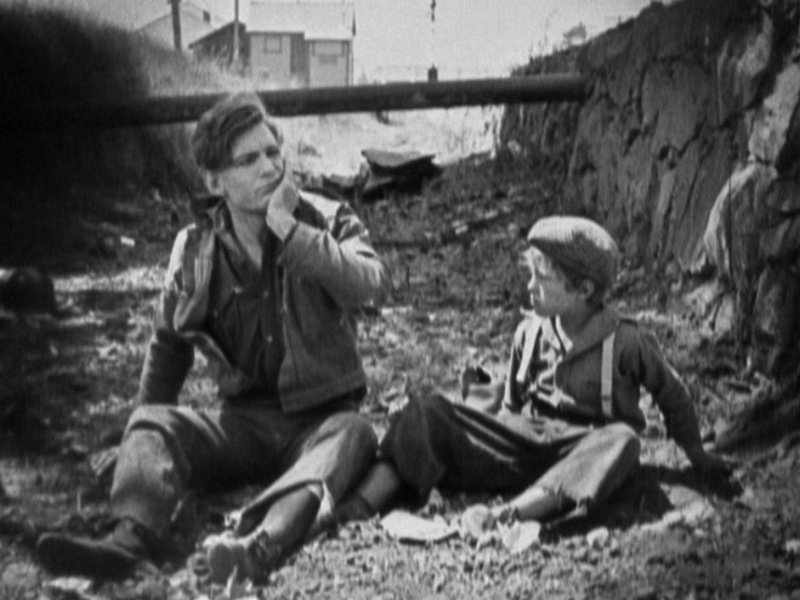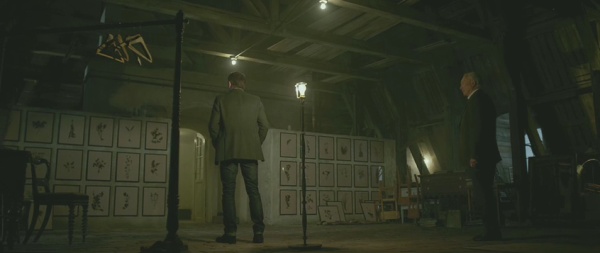2012 // USA // Mark Andrews, Brenda Chapman, and Steve Purcell // June 14, 2012 // 3D Digital Theatrical Projection (Wehrenberg Chesterfield Galaxy 14 Cine)
Arguably, Brave represents Pixar Animation Studios' first foray into honest-to-goodness fairy tale territory. Its story reverently (albeit loosely) follows the form of a Hero's Journey, and it wraps itself in the conventional "medieval fantasy" elements of the genre: castles and kingdoms, magic and battles, princesses and curses. The princess in this case is the flame-haired and quick-witted maiden Merida (Kelly Macdonald), the eldest child of Scottish monarchs Fergus (Billy Connolly) and Elinor (Emma Thompson). Merida is a master archer, and no slouch in the saddle, either, but her parents primarily see her as a valuable asset to be gifted in an arranged marriage that will preserve the fragile peace with neighboring clans. Merida is having none of this, naturally. Following her efforts to gleefully humiliate her would-be suitors (and parents), she sneaks off to sulk, and promptly stumbles upon a gnarled old woodcarver (Julie Walters) who moonlights as a witch. Spells are purchased, and things get... well, hairy.
In its broad outlines, the plot is well-worn stuff, but it's the quiet subversiveness of Brave that makes it such a delight. The film's explicit messages are fairly tame and even somewhat wooly: stay true to yourself, try to understand where others are coming from, and... try to divine your destiny from the land's mystical whispers? Something like that. It's the film's implicit messages that are really intriguing, and this is where Brave admirably demonstrates that kid-friendly genre cinema needn't engage in bloody-minded deconstruction to be bold. Most notably, romantic love is nowhere to be found in the film's story, a conspicuous absence for those who examine Disney's pop cultural products with a careful eye, but not one that draws attention to itself. Boys and romance just aren't on Merida's mind, and no handsome princes appear within the film's confines. Moreover, Merida's looks never come up in the film's dialog at all. No characters comment on her beauty, or lack thereof, and her most defining physical trait (aside from her cascade of scarlet hair) is her athleticism. Of the three suitors who appear—Young Macintosh, Young MacGuffin, and Wee Dingwall—none exhibit any interest in Merida as a romantic object. Indeed, one of the film's more fascinating turns is its late pivot from mocking the suitors to revealing them as pitiable lugs who are being bullied by their fathers. Laughably anachronistic, perhaps, but still a pleasure to see such a sentiment expressed in a Princess Tale (™).
While the film's marketing seems focused primarily on Merida's yearning for freedom and self-determination, the story is actually that of the relationship between the princess and her mother, and of their mutual need for greater empathy. As the queen, Elinor is forced to play the parental Bad Cop to Fergus' jovial, masculinity-obssessed Good Cop. It is she that is expected to prepare Merida for a life as a poised and obedient gentlewoman, and she that therefore receives the brunt of the princess' wrath. Elinor is presented as doting but also severe, demanding, and quietly despairing for her daughter's future. Strictly speaking, however, the queen isn't the villain, although neither is the aforementioned witch, nor the twisted, man-eating bear that once took Fergus' leg and still stalks the kingdom's wilds. The real Dragon that must be slain is the rift between mother and daughter. Elinor has so completely internalized the confining cultural traditions that were once foisted upon her that she no longer seems capable of expressing love save through disapproval. Merida, meanwhile, is so self-absorbed and reflexively rebellious, she cannot perceive her mother's sacrifices and pain. The inability of either woman to acknowledge the other's humanity is the film's central conflict. In other words, Brave not only passes the Bechdel Test with flying colors, it essentially repurposes the fairy tale genre for a female-centered and distinctly modern story of familial devotion and understanding.
Which is a roundabout way of saying that while Brave isn't a ground-breaking work of animation compared to Pixar triumphs such Ratatouille and WALL-E, it's still quite an extraordinary work of pop cinema, not to mention gratifyingly witty and heartfelt. It's also—as one expects of Pixar—a visually sumptuous film, from the achingly gorgeous Highland landscapes to the off-beat design of its human characters and setting details. (Regarding the latter, Brave echoes the high-water mark established by How to Train Your Dragon's dense, humorous faux-Scottish Viking milieu.) Still, the film's earnest and unapologetic absorption with a thorny female-female relationship is what truly makes it so appealing. Which is perhaps less a commentary on Brave's overall excllence than on the parched state of thematic originality in animation, even among Pixar's features. Indeed, Brave stands out among the studio's films strictly on the basis of its narrative maturity and the rich, disciplined way that its action, sentiment, and humor serve the story. The psychological sophistication of Pixar's features has grown in recent films, but Brave is not distracted by tonally off-key chase sequences (WALL-E, Up), nor is it rendered politically problematic by its affection for Übermensch (The Incredibles, Ratatouille). It's just a damn fine fairy tale, told very well.












